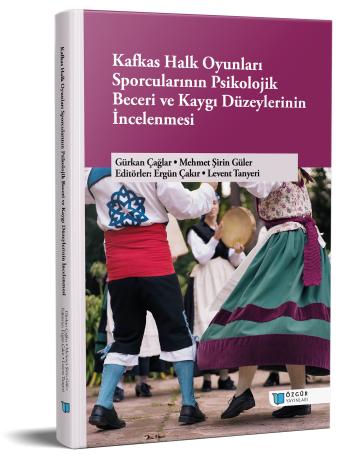
Kafkas Halk Oyunları Sporcularının Psikolojik Beceri ve Kaygı Düzeylerinin İncelenmesi
İndir
Özet
Bu araştırmanın temel problemini Kafkas Halk Dansları Sporcularının psikolojik becerileri ile kaygı düzeyleri arasındaki ilişkinin incelenmesi oluşturmaktadır. Araştırmanın alt problemlerini ise sporcuların çeşitli demografik değişkenleri ile psikolojik beceri ve kaygı düzeyleri arasında anlamlı farklılık olup olmadığı oluşturmaktadır. Farklı bir alt problem olarak da bağımsız (psikolojik beceri) değişkenin bağımlı değişkeni (kaygı düzeyi) ne oranda açıkladığı ve aralarında ne türden bir ilişki olduğunu ortaya koyabilmek oluşturmaktadır. Çalışma nicel araştırma geleneği içinde yer alan ilişkisel tarama modeline uygun olarak tasarlanmıştır. Bu bağlamda Kafkas halk danslarını icra eden toplamda 282 sporcudan Likert tipi ölçekler ile veri elde edilmiştir. Araştırmada üç ölçek kullanılmıştır. Bunlardan birisi Sporcuların Psikolojik Becerilerini Değerlendirme Ölçeği, diğeri ise Durumluk-Sürekli kaygı envanteridir. Araştırmanın verilerinin analizinde SPSS 25 programından yararlanılmıştır. Veriler normal dağılım göstermediği için parametrik olmayan testler kullanılmıştır.
Araştırmanın öne çıkan bulgularına göre sporcuların psikolojik beceri düzeyi ortalamanın altındadır. Psikolojik beceride alt faktörler içinde en yüksek puan “Güven ve Başarı Motivasyonundadır. Psikolojik Beceri’ de erkek sporcular, kadın sporculara göre istatistiksel olarak anlamlı şekilde daha yüksek ortalamaya sahiptir. Profesyonel sporcuların psikolojik beceri düzeyi amatörlere göre istatistiksel olarak anlamlı şekilde daha yüksektir. Psikolojik beceride sporcuların yaş aralığına göre anlamlı fark yoktur. En yüksek psikolojik beceri 23-27 yaş aralığındaki sporculardadır. En düşük psikolojik beceri ise 15-18 yaş aralığındaki sporculardadır. Benzer şekilde, sporcuların gelir durumları ile psikolojik beceri düzeyleri arasında istatistiksel olarak anlamlı fark yoktur. En yüksek gelir grubunda olan sporcuların psikolojik becerileri diğer gelir gruplarına göre daha yüksektir. Ancak eğitim düzeyleri ile psikolojik beceri arasında istatistiksel olarak anlamlı fark vardır. Lisans mezunu sporcular en yüksek ortalamaya sahiptir. En düşük ortalama ise ilkokul mezunu sporculardadır. Sporcuların dansa başlama yaşı ile psikolojik becerinin genel toplamı arasında istatistiksel olarak anlamlı fark yoktur ancak bazı alt boyutlarda anlamlı fark söz konusudur. 6-9 yaş arası dana başlayan sporcuların psikolojik becerileri daha geç yaşta dansa başlayanlara göre daha yüksektir. Sporcuların haftalık çalışma saati ile psikolojik becerinin genel toplamı arasında istatistiksel olarak anlamlı fark yoktur ancak bazı alt boyutlarda anlamlı fark söz konusudur. En yüksek ortalama 4-8 saat çalışan sporculardadır. En düşük ortalama ise haftalık 9-13 saat çalışan dansçılardadır. Sporcuların ilgilendikleri farklı spor branşları ile psikolojik becerinin genel toplamı arasında istatistiksel olarak anlamlı fark yoktur. En yüksek psikolojik beceri puanı basketbol oynayanlarda iken en düşük puan ise futbol oynayanlardadır.
Araştırmaya katılan sporcuların sürekli kaygı düzeyi durumluk kaygı düzeyinden daha yüksek çıkmıştır. Durumluk ve sürekli kaygı ölçeğinden alınan puanlar ile cinsiyetler arasında anlamlı fark bulunmamıştır. Ancak erkek sporcuların hem durumluk hem sürekli kaygı düzeyi kadınlara göre daha yüksektir. Lisanslı olarak halk oyunu oynama süreleri ile sporcuların durumluk ve sürekli kaygı düzeyleri arasında da anlamlı fark yoktur. 1-2 yıldır lisanslı olanların durumluk kaygısı 3-4 yıldır lisanslı olanlara göre daha yüksektir. 3-4 yıldır lisanslı olarak halk oyunu oynayan sporcuların sürekli kaygı düzeyi 1-2 yıldır lisanslı şekilde oynayanlara göre daha yüksektir. Profesyonel dansçıların durumluk ve sürekli kaygısı amatörlere göre düşüktür. Yaş grupları ile kaygı düzeyleri arasında anlamlı fark yoktur. En yüksek durumluk ve sürekli kaygı 19-22 yaş aralığında olan dansçılardadır. Dansçıların gelir düzeyi ile kaygı düzeyleri arasında anlamlı fark yoktur. En yüksek durumluk kaygı ortalaması en yüksek gelir grubunda iken en düşük durumluk kaygı en düşük gelir grubundadır. Sürekli kaygı düzeyi de en yüksek gelir grubunda olan dansçılarda diğer gelir grubunda olan dansçılara göre daha yüksektir.
Araştırmaya katılan dansçıların eğitim düzeyi ile durumluk ve sürekli kaygı puanları arasında anlamlı fark yoktur. En yüksek durumluk kaygı ilkokul mezunu dansçılardadır. En yüksek sürekli kaygı da ilkokul mezunu dansçılardadır. Dansçıların dansa başlama yaşı ile durumluk kaygı düzeyleri arasında anlamlı fark vardır ve en yüksek durumluk kaygı 6-9 yaş aralığında dansa başlayan dansçılardadır. En düşük durumluk kaygı ise 15-18 yaş aralığında dansa başlayan sporculardadır. Sürekli kaygı ile dansa başlama yaşı arasında anlamlı fark yoktur. En düşük sürekli kaygı 6-9 yaş aralığında dansa başlayan sporculardadır. En düşük sürekli kaygı düzeyi ise 15-18 yaş aralığında dansa başlayan sporculardadır. Haftalık çalışma saati ile durumluk ve sürekli kaygı düzeyi arasında anlamlı fark yoktur. 1-3 saat haftalık çalışan dansçıların durumluk kaygı düzeyi en yüksektir. 9-13 saat arası çalışan dansçılarda ise sürekli kaygı en yüksektir. İlgilenilen spor branşı ile durumluk kaygı arasında anlamlı fark yoktur ancak sürekli kaygı arasında vardır. En yüksek kaygı voleybol oynayan dansçılarda en düşük sürekli kaygı ise futbol ile ilgilenenlerdedir. Korelasyon sonuçlarına göre eğitim düzeyi arttıkça psikolojik beceri düzeyi artmaktadır. Dansa başlama yaşı düştükçe psikolojik beceri düzeyi azalmaktadır. Yani aralarında ters korelasyon vardır. Psikolojik beceri ile durumluk kaygı arasında ise pozitif yönlü düşük düzeyde anlamlı ilişki vardır.

